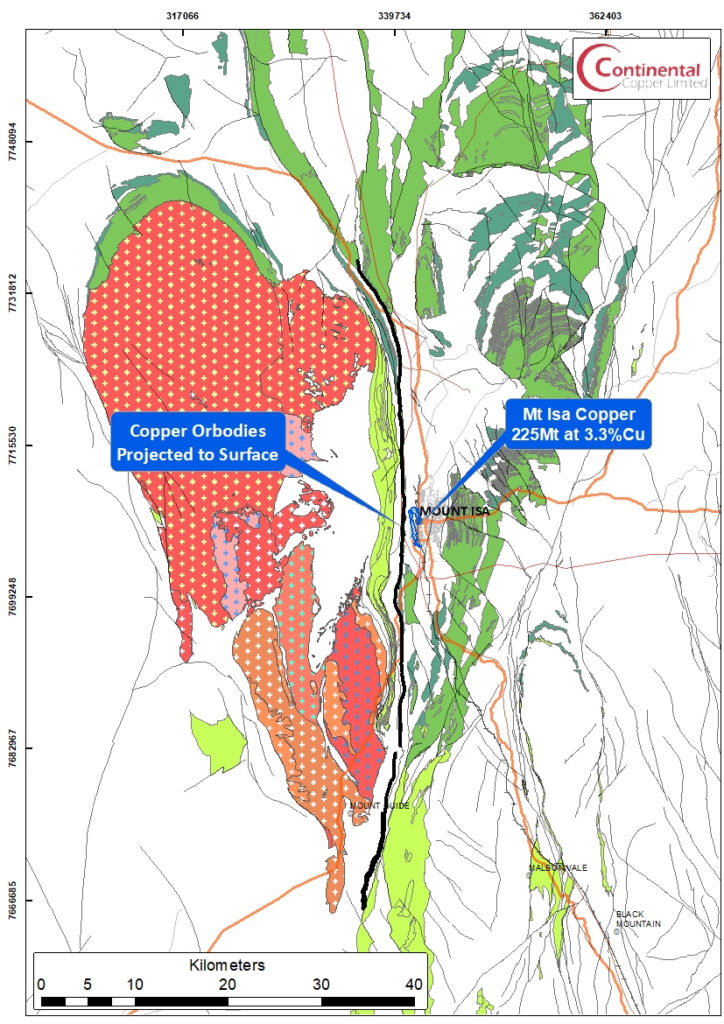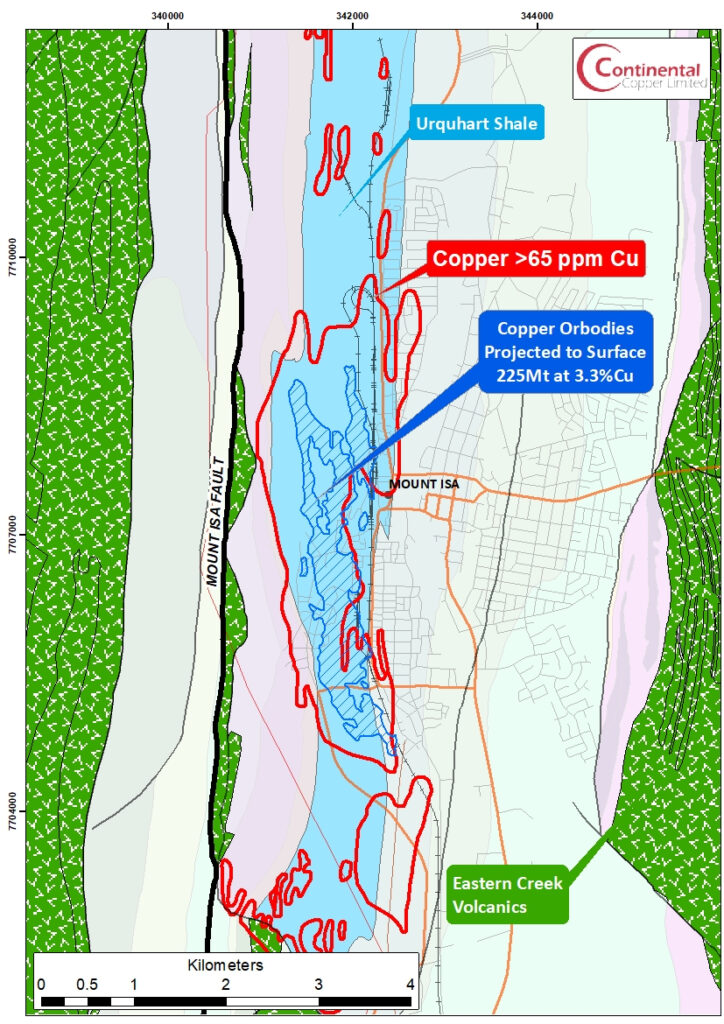Discovery of the Mt Isa Copper Deposits
Silver-lead ore was discovered at Mt Isa in 1923 but it was not until 1927 that a surface drill hole aimed to test silver-lead bodies at depth intersected 15 m of oxide copper and chalcocite grading 17% copper in the Black Rock area. This secondary mineralization was explored underground in 1937, mined intermittently for flux between 1941 and 1962, and by open cut from 1957. Combined oxide and chalcocite ore mined from the Black Rock open cut between 1963 and 1967 totaled 2.26 Mt at an average grade of 3.9% copper. It was not until 1930 while drilling lead-silver mineralization at depth that primary chalcopyrite mineralization was encountered reporting a best result of 8.8m at 8.5% Cu. Follow-up drilling in 1953 reported 17m at 2.0% Cu and in 1954 a most respectable 202m at 2.2% Cu (Perkins, 1999).
Deposit Geology
The copper mineralization is hosted entirely within a broad zone of intense silica-dolomite alteration developed above the Paroo Fault within the Urquhart Shale (~1650-1955MA). Economic copper ore bodies extend across a combined width of more than 1,000 metres and along a strike of 4,200 metres and entirely within the Urquhart Shale.

The Mt Isa mineralization is hosted within sediments of the Mt Isa Group (<1688-1650MA) which is in structural contact with the older structurally complex, metamorphosed and altered sediments and mafic volcanics of the Haslingden Group (~1793-1773MA). The Haslington Group, deposited in an intra-cratonic rift, consists of coarse sandstone and lesser quartzite, intercalated with sediments and basalts of the Eastern Creek Volcanics and intruded by the large composite Sybella Batholith (~1670-1655MA) to the west of the Mt Isa Fault. The Eastern Creek Volcanics are regionally extensive, 7-8km thick, have a tholeiitic composition and are anomalously rich in copper. The Mt Isa Group overlies the Haslington Group at Mt Isa, and is a 4-6km thick sequence of carbonaceous and dolomitic siltstone, mudstone and shale deposited in a shallow water basin.
Source of the Copper
The Eastern Creek Volcanics has been proposed as the source of the Mt Isa copper as early as 1971 due to their anomalous copper and proximity to the west and beneath the copper orebodies. (Smith and Walker 1971; Wilson et al. 1985; Hannan et al. 1993; Heinrich et al. 1995). Bain et al. 1992; Hannan et al. 1993; Heinrich et al. 1995 and Graham et al. 2006, have suggested models, based on alteration studies, whereby oxidized fluids circulated through the volcanic rocks via major structures, leaching copper which was then deposited in the overlying Urquhart Shale.
Graham 2006, compiled the scant and now dated regional scale whole rock data from the OZCHEM data and Xstrata and argued that potassic-altered Eastern Creek Volcanic metabasalt have significantly lower Cu concentrations compared with the unaltered (low K2O) equivalent metabasalt. Combined with petrographic studies and LAICPM work they concluded that:
- The Eastern Creek Volcanics are a potential source of copper for the giant sediment-hosted Mount Isa copper deposit.
- Laser ablation ICP-MS analyses of iron–titanium oxides within the metabasalt demonstrate that copper was mobilized during the metamorphic breakdown of magmatic titanomagnetite (and chalcopyrite) and growth of metamorphic magnetite.
- Copper hosted within titanomagnetite is not incorporated into metamorphic magnetite, and petrology and geochemical modelling suggest that this copper could have precipitated with syn-metamorphic epidote.
- The epidote alteration zones refractured due to post-metamorphic deformation, which allowed oxidized potassium-rich fluids to remobilize copper from the Eastern Creek Volcanics and ultimately deposit some of it in the overlying reduced sedimentary rocks.
- The oxidized nature of epidote allowed the fluid to remain oxidized and therefore carry significant concentrations of copper in solution. Potassium-rich phases such as K-feldspar represent the regional expression of the ore-forming fluid.

A Mt Isa Analogue
If you are looking for a Mt Isa analogue you would want the following:
- Carbonaceous siltstones and shales close enough to a postulated rift margin
- Proximal to a major crustal structure with local geological heterogeinity
- Voluminous mafic rocks within the stratigraphy which could be a potential metal source
- Subdued magnetic response as little magnetite will be formed in such reduced rocks
Sources
Perkins W G 1990 – Mount Isa copper orebodies: in Hughes FE (Ed.), 1990 Geology of the Mineral Deposits of Australia & Papua New Guinea The AusIMM, Melbourne Mono 14, v1 pp 935-941




One thought on “The Eastern Creek Volcanics: Source for the 8 Mt Copper Deposits at Mt Isa”